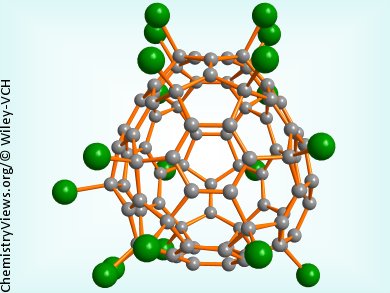The structures of higher fullerenes, i.e., those above C70, are often hard to determine, as the species are only produced in small quantities and are often unstable. Derivatization, for example with chlorine, presents one avenue to stabilizing structures and allowing characterization of otherwise elusive isomers. Sergey Troyanov, Moscow State University, Russia, and collaborators at the University of Science and Technology of China were able to confirm the existence of Cs-C82 isomer 4 (numbered according to P. W. Fowler and D. E. Manolopoulos) by chlorination and characterization of the derivative C82Cl20.
Chlorination of a mixture of C82 and C84 with VCl4 in a glass ampoule for two months at 340 °C led to formation of small yellow crystals, which X-ray diffraction with synchrotron radiation revealed to be C82Cl20 with the carbon cage connectivity of Cs-C82 (4). In the chlorinated derivative, only three chlorine atoms deviate from the mirror symmetry of the Cs cage, and the overall chlorination pattern is stabilized by the formation of aromatic substructures and isolated C=C bonds. Density functional calculations and comparison with the most stable C82 isomer 3 ruled out the possibility of skeletal transformation induced by chlorination.
The authors comment that their results are a significant contribution to the chemistry of higher fullerenes.
- A New Isomer of Pristine Higher Fullerene Cs-C82 (4) Captured by Chlorination as C82Cl20,
Shangfeng Yang, Tao Wei, Sergey I. Troyanov,
Chem. Asian J. 2012.
DOI: 10.1002/asia.201201038 - An Atlas of Fullerenes,
P. W. Fowler, D. E. Manolopoulos,
Clarendon, Oxford, UK, 1995.
ISBN: 978-0486453620
Also of interest:
- Identification for IPR Isomers of Fullerene C82 by Theoretical 13C NMR Spectra Calculated by Density Functional Theory,
Guangyu Sun and Miklos Kertesz,
J. Phys. Chem. A 2001, 105, 5468–5472.
DOI: 10.1021/jp004544z




